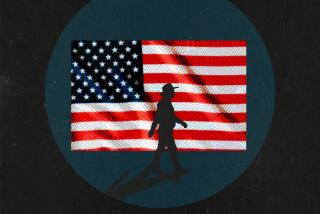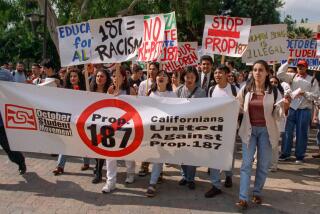Prop. 54 Could Undermine Racial Gains
It would seem a contradiction. Californians elect the first Mexican American governor in modern times and also approve an ostensibly conservative Proposition 54, which would prohibit the state from recognizing racial and ethnic categories. But the Mexicanization of California makes both political events possible.
In the 1920s, Texas economist Max Handman noted that America had “no social technique for handling partly colored races.” Mexicans’ intermediary status in the racial taxonomy has always caused confusion. Legally considered white yet treated as nonwhites, Mexican Americans have sought to capitalize on their in-between status. The Mexican American experience is thus more creative acculturation than resistance to the mainstream. Eager to retain aspects of their ancestral culture while becoming American, the children and grandchildren of Mexican immigrants have been adept at cultural mixing. Not surprisingly, Mexican American political advances have been less a product of solidarity and insurrection than of versatility and integration.
The media, in pursuit of the next great social movement, are tone-deaf to the Mexican American experience of incremental cultural and ethnic fusion and gradual political gain. That may explain why Newsweek called Mayor James K. Hahn’s victory over Antonio Villaraigosa in the 2001 L.A. mayoral race a “brownout.” The magazine was expecting the “Latino future” to arrive with the force of a sunburst. So it missed the city’s quiet and historic transition into a new era. Within a month after Villaraigosa’s defeat, two of the three highest posts in city government were occupied by Mexican Americans.
In 1958, when Pat Brown won the governorship by more than 1 million votes, California’s largely white electorate rejected Democrat Henry Lopez’s bid for secretary of state. Anglo California simply wasn’t ready for a Mexican American in statewide office. Forty years later, Cruz Bustamante, a moderate and by no means a standard-bearer of an ethnic movement, became the first Mexican American to hold statewide office in a century. In 1998, roughly three in four of his supporters were non-Latinos.
The advances of the civil rights movement certainly created a more tolerant atmosphere for minority groups to rise politically. The globalization of American culture also has made whites more receptive to ethnic influences. But Mexican Americans themselves have helped to break down barriers and dismantle rigid notions of race. With roughly two-thirds of the interethnic or interracial marriages in California involving a Latino partner, Mexican Americans are the primary catalysts for the state’s growing rate of intermarriage, which is five times higher than the nation’s. Nationwide, Latinos, two-thirds of whom are of Mexican origin, make up more than 70% of Americans who eschew all racial classifications and check “other” as their race on the census.
More than any other single group, Mexican Americans have created the demographic conditions that UC Regent Ward Connerly says justify what he calls his Racial Privacy Initiative. Contending that the rising frequency of intermarriage has made the concept of race irrelevant, Connerly’s measure would prohibit the state from collecting racial data except for medical and law-enforcement purposes. But the goal of his initiative -- to eradicate racial categories -- obscures the more subtle yet profound changes that increased racial and ethnic mixing is bringing to California.
Mexican migration to the Golden State has resurrected some of the racial dynamics that existed at the founding of Spanish California. Two centuries ago, mestizos (people of mixed heritage) undermined the logic of another racial classification system.
In 1781, when Jose Vanegas arrived with the original 46 settlers of Los Angeles, he was classified as an Indian in the Spanish census. Nine years later, he was “upgraded” to a mestizo. Similarly, Jose Navarro arrived as a mestizo but was reclassified as Spanish in 1790. Many others asked to be racially re-categorized in the first decade of settlement.
Though frontier Mexicans were not oblivious to race and tended to favor lighter-skin individuals, skin color alone was not a major obstacle to social mobility. Because racial categories on Mexico’s northern frontier were so malleable, the upwardly mobile frequently “whitened” themselves to obscure Indian or black ancestry. Still, men like Pio Pico, who had Indian and African blood, could rise to become governor of Mexican California. Race was as much an economic and cultural category as a physiological one. Anglo Americans viewed “Indian” as a racial classification, but Mexicans understood it as a cultural one. An Indian was not simply someone with Native American blood but an individual who behaved and spoke “like an Indian.”
For three centuries, Spain had sought to maintain separation among the races in Mexico through imposition of a hierarchical racial order. Whites, Indians, mestizos and blacks were afforded different levels of access to property, power and prestige. But through the centuries, racial mixing eroded both the categories and the racial order. As racial classification became more difficult, race became secondary to class as a determinate of social standing. The Spanish system of racial hierarchy broke down even more rapidly on the northern frontier.
Because there were so few Spaniards of “pure” European lineage available to settle the north, most pioneers to California were mestizos, Hispanicized Indians and blacks. Seven of the 11 founding families of Los Angeles were marked by some degree of intermarriage. And the mixing continued in California. In 1784, Carlos Rosas became the first settler in the L.A. area to marry a local Indian.
Racial prejudice in California at the turn of the 19th century was much tamer than in the United States and the interior of Mexico. But even as racial fluidity undermined the Spanish segregationist system, it did not end racial bias.
In 1821, Mexican independence from Spain brought an official end to the racial categorization system. Although racial labels were used by census takers, they no longer had formal legal meaning. All Mexicans were equal citizens before law. More than a century and a half later, no one would claim that Mexican society was free of racial and ethnic biases. Government fiat could not eradicate the social differences in people’s minds. Furthermore, the advances racially mixed Mexico did make, particularly in 19th century California, were products of changing social attitudes, not politics.
California society has made great strides toward achieving Connerly’s vision of a racially fluid place. Ironically, his initiative threatens to undermine some of that progress. The historical conflict between whites and blacks conditioned Americans to view race in polarizing, mutually exclusive terms. But the growing presence of a racially mixed population has begun to soften the lines between “us” and “them.”
Yet the stale debate over Proposition 54 -- between those who think race is irrelevant and those who think it is paramount -- only revives the divisive, binary thinking that has made racial diversity such a painful experience in the United States. California history tells us that both sides are missing the point.
More to Read
Get the L.A. Times Politics newsletter
Deeply reported insights into legislation, politics and policy from Sacramento, Washington and beyond. In your inbox three times per week.
You may occasionally receive promotional content from the Los Angeles Times.










